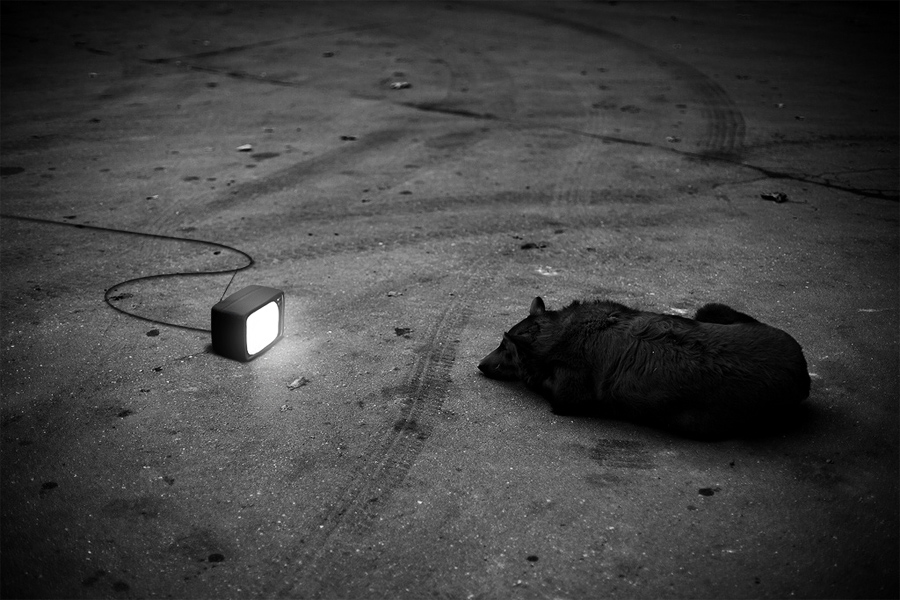The mainstream media today incriminates anyone who tries to voice an opinion other than their prescribed opinion capsule, says Bishwadeep Mitra.
The mainstream media has transformed somehow from being the appendage of the nationalist state to acting as the face of the nation. The burgeoning of violent exclusionary nationalism in the mainstream media can be witnessed on these famous talk shows as they are getting converted into courtroom trials and people are persecuted after being called in to ‘listen’ to their perspective.Objectivity, credibility and ruthless, meticulous verification of facts are subjugated in favour of the jingoistic nationalist rhetoric.
We can graph this steep rise of nationalistic sentiments among the mainstream media right from the Jawaharlal Nehru University fiasco, which put the student-activist Umar Khalid on trial in Arnab Goswami’s ‘The Nation Wants To know’. The show persecuted him for trying to initiate a long forgotten dialogue: the dialogue of Afzal Guru. Umar Khalid and like-minded individuals organised an event commemorating the death anniversary of Afzal Guru, bringing in fore the Kashmir issue with Guru being its locus.The immediate reaction of the presumable ‘Nation’ was Umar Khalid is sympathising with a ‘terrorist’ and to substantiate the statement doctored videos got circulated via two mainstream news channels, Times Now and Zee TV News. The videos were of the programme organised by Khalid where anti-India slogans were raised, ‘inciting violence’ to destroy the nation. For a day or two, the ‘Nation’ or the perception of the media of what the nation is flew with nationalistic rage forcing Umar Khalid and the other organisers of the event to go into hiding.
Even after the forensic report proved that the videos used to persecute Khalid and his companions were doctored, not much has changed in the rhetoric of the mainstream. This violent refusal to learn from the past has led many to think that from being the extension of the nationalist state, the mainstream media has started deciding for the state itself, in light of the recent Uri Attack.
After 18 soldiers got martyred in Uri,The Times of India website showed a poll which claimed 62% of Indians want violent retribution against Pakistan, the presumable hotbed of terrorism.
While such statistical measures of the nerve of the country always go unchecked, their effects on the mass psychology are not. Coupled with it are distortion of facts and fervent propagation of the same.
Headlines in television and newspapers read almost identical while the conclusions brought out by them varied. Some of the channels explored the various options present at hand for India, which predictably hinted about war (NDTV), while others vehemently propagated revenge and retribution as the only option (Times Now). The formula to thrust the population into the manufactured cells of nationalism has been astonishingly similar to that of the JNU fiasco. Facts have been distorted and till date the respective channels and newspapers have not been held accountable. For instance,news reports suggested the weapons of the four slain terrorists bore Pakistani marks on them, thereby confirming Pakistan’s involvement in the event. Confusion arose when the Indian army itself rubbished such claims. This declaration has not been much heard of in the media. Question arises on the credibility of media and we can be certain that it won’t be answered just as in the case of doctored videos.
The home minister termed Pakistan a ‘terrorist state’ akin to the communal and nationalistic philosophy of the ruling party. But it is deeply problematic when even the media reports are in tandem with the vitriol spewed by the powers that be. It was reported that Pakistan has been isolated in the international political scenario after the Uri massacre. The international community strongly condemned the terror attack as is normal after any human tragedy. But the nationalist media declared this condemnation to be a political isolation of Pakistan from the international political scene. It must be reminded time and again that Pakistan’s involvement in the terror attack has not yet been proved, but has been assumed so. Both the nations continue with their vitriolic speeches covering the news feed and in its midst stands the common man dazed and confused. The methods of declaration in almost all the major newspapers and channels did not differ much. But events unfolded in a completely different trajectory. Pictures of Russian military in Rawalpindi in light of the first-ever joint military exercises got circulated in social media two days after the supposed international ‘isolation’ took place. How is it possible that the country which lost in international diplomacy two days ago, is executing joint military operations with one of the most powerful nations of the world? Why would Russia be an enforcer of the supposed international isolation as posed by the Indian media and go on to maintain diplomatic ties with the isolated country? Again, not much has been spoken about these rising anomalies and harmful conjectures drawn by the media. After the recent firing in Baramulla in the night of October 2 and the supposed fight going on between the Indian forces and terrorists, hatred will only grow as conjectures sharpen themselves with more hatred. Anyone even thinking about questioning the claims of the government or its mouthpiece, the media, are called upon and ridiculed or silenced by the likes of Arnab Goswami.One look at the amount of articles of differing viewpoints which have been produced in the past one week is enough to numb, daze and confuse one’s mind. The United Nations’ report said that the mission tasked to monitor the ceasefire line between India and Pakistan did not ‘observe’ any cross-border firing. Infiltration and terror attack from POK (Pakistan Occupied Kashmir) to Indian Territory continue at an exponential rate, as reported by all the mainstream channels. The only suspicious as well as funny part is the Indian government vehemently rubbishes any claim that opposes its own; like it did with the UN report on surgical strikes. The fact that it is ready for war with its neighbour and too arrogant to budge reflects in the dominant paradigm of mainstream news reporting. Even if the Army or the Government releases videos and reports of the surgical strikes, as they did on October 5, questions still arise on the credibility of the same. But who shall speak lest they are witch-hunted by the ‘Nation’ again?The recent cross border surgical strike that has affected the very architecture of Indo-Pak relations is going through tumultuous exchange of facts and reports between the media and the Government.
The media today incriminates anyone who tries to voice an opinion other than their prescribed opinion capsule. Bollywood has got polarised over the India-Pakistan issue. Pakistani artists like Fawad Khan and Atif Aslam not voicing their sympathy with the martyrs of Uri attack is synonymous with supporting terrorists, as we see all over the news. The recent victim of which has been the veteran actor, Om Puri.
Does banning of Pakistani artists decrease the chances of cross border infiltration? Or is it the chest-thumping pride of ultra-nationalists which gets satiated through such shows and debates?
The communal party in power and its outfits are hell bent to declare war on Pakistan and they are using all the means at their disposal to disseminate hatred. The media acts as a nationalist opinion monger while maintaining the façade of debate and democracy. This is not a fight against terrorism anymore. The media turned it into a war of prestige. While the United Nations reported it has not observed any cross border firing across the LOC, the Government is ever ready to reject its claims. While the public opinion is increasingly against any kind of war, hate-mongering communal outfits and parties subjugate such voices by not reporting them through the nationalistic media.
Effects of Media Jingoism on the audience
This chain of flagged, unchecked reports is reminiscent of the hanging of Afzal Guru and rightfully so. Afzal Guru was hanged based on circumstantial evidence. The Supreme Court declared that the hanging was necessary to appease ‘the collective conscience’ of the society. A look at the subsequent news reports of all the mainstream channels and newspapers show us how the ‘collective conscience’ was bent, distorted and perverted so much so that the whole nation legalised the institutional murder of Afzal Guru. The point being, extensive propagation of any message, without checking the facts behind them can have exponential effects on the mass psychology of the population. Even though Supreme Court passed the judgement that Guru’s confession was forced by the police, to satiate the collective conscience a person was murdered with everyone’s consent. The consent was achieved and manufactured by the national media. The event recurred when a fake lynching video (the lynching in the video had actually taken place in Pakistan two years back) was allegedly circulated via Whatsapp by the RSS (Rashtriya Swayamsevak Sangh) in Muzaffarnagar in 2013. The fake video caused mass upsurge leading to riots leaving 62 dead and more than 50000 displaced. It is correct to assume that the population does not check facts, it does not delve into intricacies. While this event is unrelated to mainstream media, we can gauge the power of a simple Whatsapp video on an already polarised population. Its faith in media is increasingly taken advantage of, be it for manufacturing riots or manufacturing legitimacy to kill an innocent person.Yet the mainstream media has not learned about its omniscient effect on the population.
It is time to start asking the right questions about the agenda of the media, and whether all these mistakes can be rightfully named ‘mistakes’!
While the mainstream media is busy distorting facts and bending opinions to its nationalistic will, it completely ignores the war that this system has waged on its own people. For every false report of Pakistani involvement in every terror issue of India, the media ignores the mass murder of Adivasis in Chattisgarh or Jharkhand.
There has been a terribly heart-wrenching silence over the recent indiscriminate firing of the CRPF over adivasis in Jharkhand over land row, which killed six people. The news still waits in the long queue with other grave criticisms of this government because apparently the ‘Nation’ does not want to know! Why is it so? Which democracy and development do we talk about when the most vulnerable sections of the society are left to death and destruction for its sake?
It takes an acid attack on Soni Sori to remind the arrogant media that Chattisgarh is relevant too.
There is a media blackout in adivasi heartlands as well as in Gujarat. The recent Dalit agitation and its violent handling by the Gujarat government has been shoved in some corner and the nationalist media walks carefully around it, reducing it to two mere paragraphs between page 2 and page 3. When SoniSori’s sister was kidnapped, the news got circulated via Facebook, which led to street corners and agitations in different cities across the country. Few days back the kidnapping of activist Jignesh Mevani by the Gujarat Police got reported by the group Dalit Camera via Facebook again.
The rise of alternative news media in the contemporary times primarily owes to the vacuum created by the silence of the mainstream on issues, which firmly criticise the government and its policies. Then again the alternative media has its limitations, its reach being the largest determining factor.
Its mainstream counterpart prides itself over its grasp of the large count of audience cutting across all sections of society, thereby having a monopoly over which events to get reported and which not to, which voices to get heard and which not to. That is why it makes headlines when a family member of one of the deceased in Uri attack decides to sit on hunger strike in demand of war while the hunger strike of the Honda workers and quelling of such protests by the administration barely make the second page.
Image via http://www.freshminds.net/


